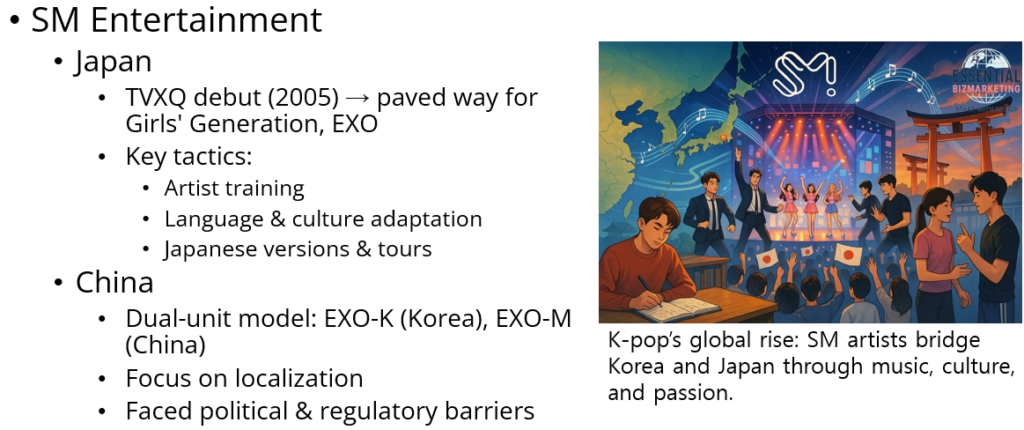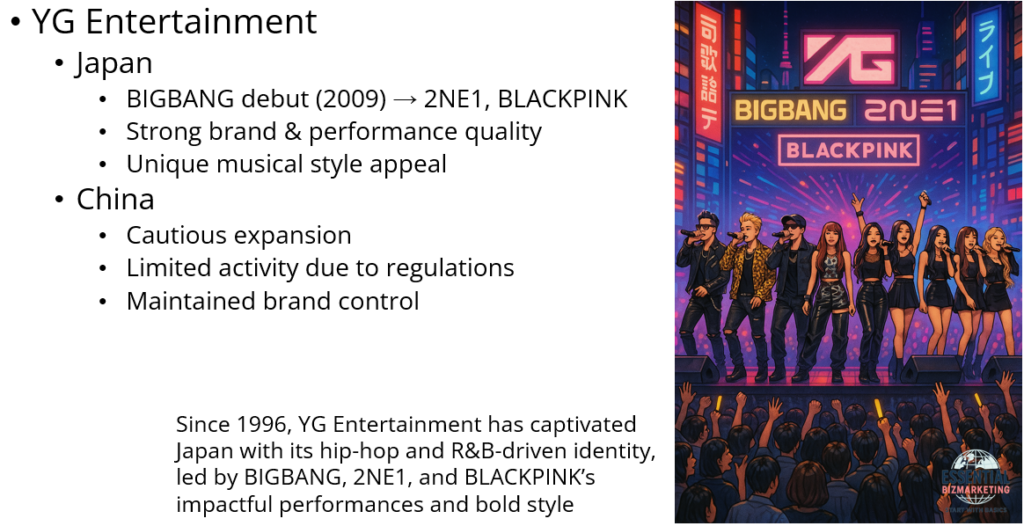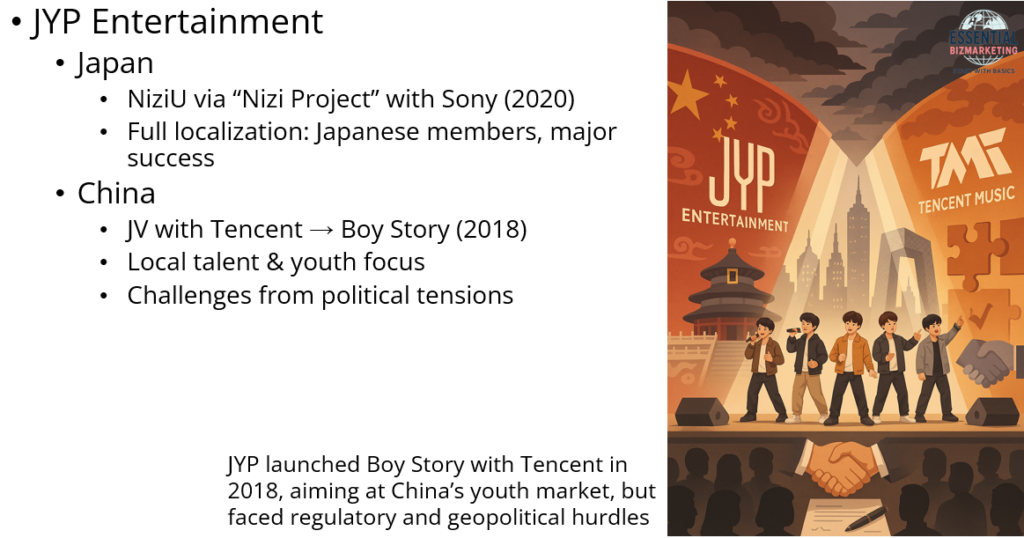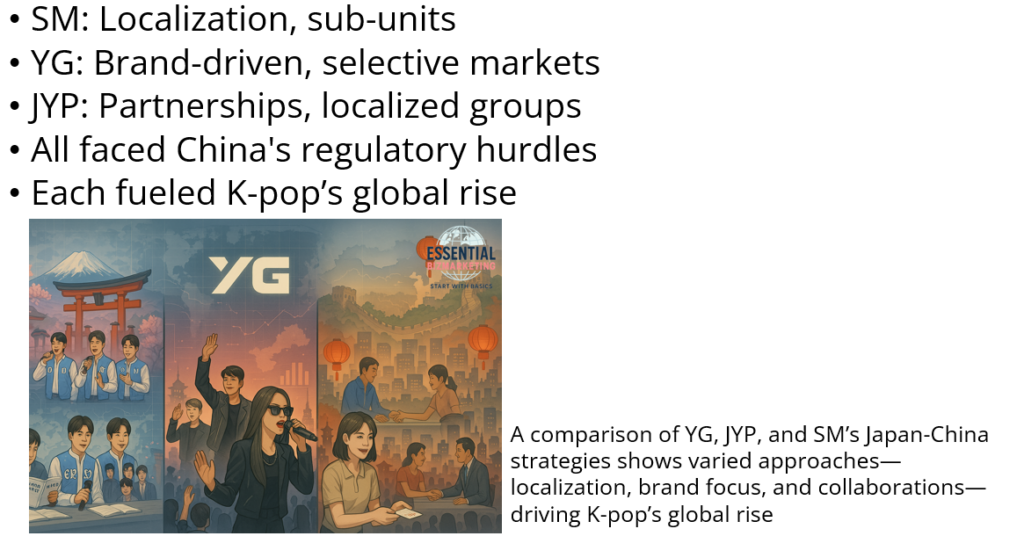The global proliferation of K-pop has been significantly influenced by the strategic endeavors of South Korea’s leading entertainment companies: YG Entertainment, JYP Entertainment, and SM Entertainment. Each of these companies has employed distinct approaches to penetrate and establish a foothold in the Japanese and Chinese markets, reflecting their unique visions and operational philosophies.
SM Entertainment’s Market Strategies

SM Entertainment, established in 1995, has been a pioneer in the globalization of K-pop. The company’s strategy in Japan was marked by the successful debut of TVXQ in 2005, which set the stage for subsequent acts like Girls’ Generation and EXO to enter the Japanese market. SM’s approach involved rigorous artist training and localization, including Japanese language proficiency and cultural adaptation, facilitating deeper connections with the Japanese audience. This meticulous preparation enabled SM artists to release Japanese versions of their songs and conduct extensive tours across Japan, thereby solidifying their presence.
In China, SM Entertainment adopted a strategy of forming sub-units tailored to the Chinese market. A notable example is EXO, which debuted in 2012 with two sub-groups: EXO-K, targeting the Korean market, and EXO-M, focusing on the Chinese audience. This dual approach allowed SM to cater specifically to regional preferences and language, enhancing their appeal within China. However, the company faced challenges due to political tensions and regulatory changes affecting cultural exports, which impacted their operations in the Chinese market.
YG Entertainment’s Market Strategies

YG Entertainment, founded in 1996, is renowned for its emphasis on hip-hop and R&B genres, fostering a distinctive musical identity. In Japan, YG’s strategy revolved around leveraging the unique styles of its artists to captivate the Japanese audience. BIGBANG, one of YG’s flagship groups, made a significant impact in Japan with their debut in 2009, followed by successful ventures from 2NE1 and BLACKPINK. YG focused on creating a strong brand image and delivering high-quality performances, which resonated well with Japanese fans.
Regarding the Chinese market, YG Entertainment’s approach was more cautious. While the company recognized the potential of China’s vast audience, it faced challenges due to regulatory constraints and political sensitivities. Consequently, YG’s activities in China were relatively limited compared to its endeavors in Japan. The company prioritized maintaining its brand integrity and focused on markets where it could operate with greater flexibility and creative freedom.
JYP Entertainment’s Market Strategies

JYP Entertainment, established in 1997, has been strategic in its international market penetration. In Japan, JYP’s approach involved forming partnerships and creating groups specifically tailored for the Japanese market. A prime example is NiziU, a girl group formed through the “Nizi Project,” a joint venture with Sony Music Japan. Debuting in 2020, NiziU comprises Japanese members and has achieved remarkable success domestically, reflecting JYP’s commitment to localization and collaboration.
In China, JYP Entertainment pursued a strategy of forming local partnerships and developing groups aimed at the Chinese audience. The company established a joint venture with Tencent Music Entertainment Group, leading to the debut of the boy group Boy Story in 2018. Comprising Chinese members and targeting young audiences, Boy Story represents JYP’s efforts to integrate into the Chinese market through localization and strategic alliances. However, similar to its counterparts, JYP faced challenges due to regulatory changes and geopolitical factors affecting cultural exchanges between South Korea and China.
Conclusion

The comparative analysis of YG, JYP, and SM Entertainment’s strategies in Japan and China reveals a spectrum of approaches, from SM’s meticulous localization and sub-unit formations to YG’s brand-centric focus and JYP’s collaborative ventures. These strategies underscore the complexities of international market penetration in the entertainment industry, highlighting the need for cultural sensitivity, adaptability, and strategic partnerships. Despite the challenges, the concerted efforts of these companies have significantly contributed to the global prominence of K-pop.
📚 References
Goh, J. Y. Q., & Ngo, S.-S. (2024). An analysis of SM Entertainment’s ownership structure amidst its global-local expansion. Media, Culture & Society, 47(1), 3–21. https://doi.org/10.1177/01634437241271001
JYP Entertainment. (2018). JYP Entertainment Expansion to International Markets in USA, China, and Japan. https://ejournal.umm.ac.id/index.php/GLI/article/download/23142/11638/78458
Kim, S. H. (2017). Comparative Discourse on J-pop and K-pop: Hybridity in Contemporary Local Music. Korea Journal, 60(1), 40–63. https://accesson.kr/kj/assets/pdf/8509/journal-60-1-40.pdf
Fan, Q. (2025). Differences and Commonalities in the Marketing Strategies of Chinese and Korean Entertainment Companies. Advances in Economics Management and Political Sciences, 150(1), 172–177. https://www.researchgate.net/publication/387773278_Differences_and_Commonalities_in_the_Marketing_Strategies_of_Chinese_and_Korean_Entertainment_Companies
DBS Bank. (2018). JYP Entertainment. https://researchwise.dbsvresearch.com/ResearchManager/DownloadResearch.aspx?E=dgfiekQEByd191c2VyaWRAQA%3D%3D
SHS Web of Conferences. (2024). Business Model and Development of Korean Brokerage Companies. SHS Web of Conferences, 208, 04010. https://www.shs-conferences.org/articles/shsconf/pdf/2024/28/shsconf_dsm2024_04010.pdf
StoryMaps. (2024). Korean K-pop’s Tailored Approach to Captivate Japan Market. https://storymaps.com/stories/502da3e28fdb47318fe9367b15b711bf
📁 Start exploring the Blog
📘 Or learn more About this site
🧵 Or follow along on X (Twitter)
🔎 Looking for sharp perspectives on global trade and markets?
I recommend @GONOGO_Korea as a resource I trust and regularly learn from.
